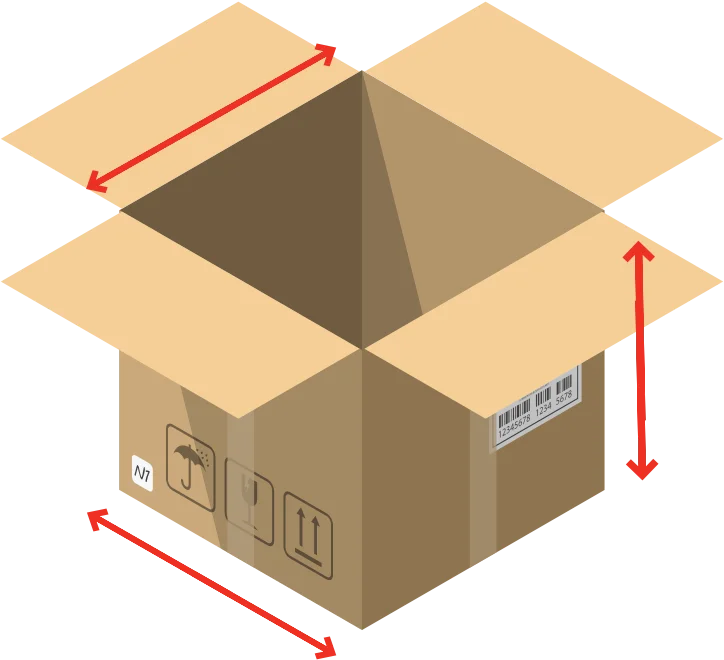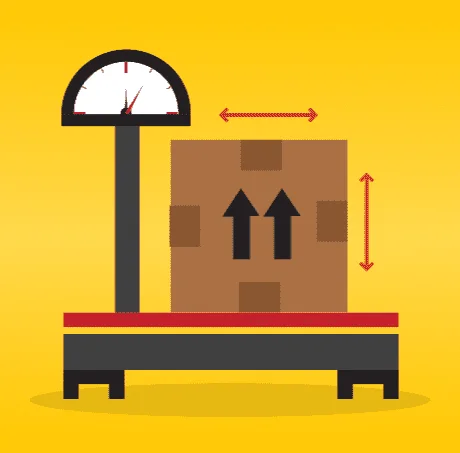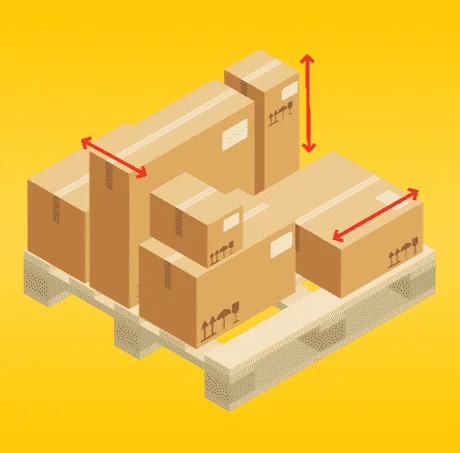
Need to send freight but not sure how to work out the volumetric weight?
Here’s a calculator to make it easy, as well as the formula and all the information about calculating freight weights & sizes that you need to arrange freight or courier deliveries.

Measuring the size of an item is fairly straightforward. There are three measurements you need:
Measurements are to always be made in metres.
If your freight or parcel is odd shaped, it’s important that the width measurement is made 90 degrees to the length measurement (i.e. forming a cross).

The formula for volumetric weight is:
length x width x height x cubic conversion = volumetric weight
0.5 x 0.4 x 0.3 x 250 (or 333) = 15kg (or 20kg)
NOTE: The freight dimensions must be measured in metres, not millimetres or centimetres.

Cubic conversion is used by couriers and freight companies to achieve an actual weight that is comparable to the cubic dimensions of the freight.
For example, let’s say you want to send a cubic metre of feathers across the country. Its actual weight might only be 1 kg but it takes up a lot of space on the truck. This limits how much other freight can be loaded with it, and if the freight company only charged by actual weight, they would most likely lose money.
So a comparable conversion factor is used to ensure that the cubic metre of feathers is charged an appropriate amount for the space it takes up on the truck.
Most freight companies use a cubic conversion factor of 250 or 333.
That is…
1 cubic metre of space = 250kg
1 cubic metre of space = 333kg
Freight and courier drivers rely on knowing the sizes and weights of their cargo to be able to plan and carry out deliveries as safely and efficiently as possible. In addition, giving the correct size and weight information helps us provide you with an accurate quote, delivery time, and allows us to allocate an appropriate vehicle for transportation.

The actual weight of an item – also sometimes referred to as gross weight or deadweight – is probably the easiest thing about the item to measure.
Weight should always be measured in Kg’s.
Measurement can be made with any suitable scale. For the most accurate weight measurement, use scales that are calibrated regularly. The scales at Aussiefast are calibrated every 3 months.
For more information on Aussiefast’s range of delivery services, please see our linehaul freight and courier pages.
If you have any questions at all about calculating freight weight, please call us or feel free to leave a message below and we’ll respond to you.
|
!! SCAM ALERT !!
Please CLICK HERE for more information. |
Dear valued community,
It has come to our attention that there are scammers impersonating Aussiefast and our services.
Your safety and trust mean everything to us, and we want to ensure that you stay informed and protected.
All legitimate freight bookings with Aussiefast will ONLY ever be made through our official website www.aussiefast.com.au or via direct email at info@aussiefast.com.au
Please carefully check the credentials of any emails or messages you may receive, to make sure they are sent from Aussiefast Transport Solutions. Scammers can slightly change wording to make themselves look legitimate at first glance, so please be vigilant.
Scams can be sophisticated, so please be aware of any 3rd party sellers on social media claiming to use our services, and asking you to pay fraudulent invoices from ‘AUSSIE FAST LOGISTICS’.
If you ever find yourself in doubt or suspect any fraudulent activity, we urge you to call us directly at 13 13 64 before making any payments. Our dedicated team is here to assist you and confirm the legitimacy of any transaction.
Your safety and security are our top priorities. Let’s work together to keep our community free from scams and ensure a safe experience for everyone.
Thank you for your continued trust and support ❤
– The Aussiefast Team
Aussiefast Transport Solutions may require the collection of personal information to satisfy the needs of the organisation. The reasons for the collection of the personal information include, but are not limited to, communication about our services, for quality or training purposes, administrative purposes, creating and updating our database, invoicing, depot recovery, resolving disputes, ensuring contractual and legal compliance, processing credit checks and internal record keeping
The personal information may be required for the purpose of:
Aussiefast Transport Solutions may also collect the information for the provision of marketing, unless a specific request in writing is provided, detailing what is not required.
Aussiefast Transport Solutions may need to give personal information to other organisations to comply with its legal obligations, such as auditors, legal advisers and the Australian Taxation Office (or any other relevant organisations).
Aussiefast Transport Solutions may disclose personal information, for the purposes set out above, to any of its subsidiaries, branches, franchises or legally related companies, agents, dealers or contractors. Disclosure to external parties or entities does not occur without the individual’s consent except where disclosure is required by law. Aussiefast Transport Solutions is unlikely to be required to disclose personal information to overseas recipients.
Aussiefast Transport Solutions acknowledges that there is no obligation for an individual to provide it with personal information. However, if an individual chooses not to provide Aussiefast Transport Solutions with personal details, it may not be able to provide the individual with a full range of services or may reduce the ability of directly servicing the individual’s organisation.
The Privacy Act 1988 provides the right to access personal information held by Aussiefast Transport Solutions. If the information is inaccurate, a request can be made to correct it.
Aussiefast Transport Solutions reserves the right to charge a nominal fee if required for the retrieval of information requested.
Further information can be obtained by contacting Aussiefast Transport Solutions nominated privacy officer. A copy of the Australian Privacy Principles can be accessed at Read the Australian Privacy Principles – Home (oaic.gov.au)
How can we help?
Fill out your job details and we’ll return to you with a quote asap!